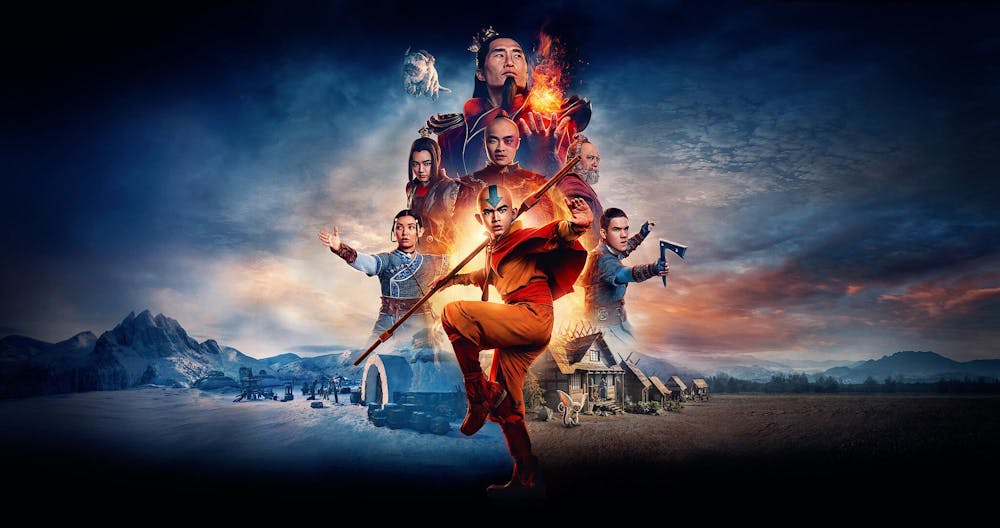Remaking a classic is never easy — especially when the original is a cartoon unrestrained by budget, special effects or the laws of physics in which characters can manipulate water, earth, fire and air. But the Netflix live-action remake of the beloved series “Avatar: The Last Airbender,” released Thursday, juggles those difficulties with grace — injecting life into the animation’s vibrant cities, mystical forests and terrific powers. But while the 2024 version successfully captured the most fantastical, majestic details of the show, it failed to highlight what made the show truly unique: humorous heart and the loveable characters.
The world of ATLA, which was first released as an animated series in 2005, is organized through four element-based nations — water, earth, fire and air. While some people have the power to control their nation’s respective elements, only the Avatar can master all four. Aang, a young but powerful airbender, discovers he is the next Avatar right before the Fire Nation starts its domination of the other nations. While trying to run from his fate, Aang becomes trapped in a ball of ice for 100 years, incidentally avoiding the Fire Nation’s annihilation of the Air Nation. When Aang is awoken by two young Water Tribe siblings, Katara and Sokka, he is still 12, but the rest of the world has moved on, suffering under the Fire Nation’s rule. The show then follows the trio’s efforts to free the world.
The live-action remake features eight episodes, each around an hour, compared to the original’s 20 episodes of about 23 minutes each. As a result, the remake combines stories and plotlines that were separate in the animated version, introducing certain key characters, like Azula and Fire Lord Ozai, long before they’re introduced in the original — shifting the focus of the series from the lighthearted individual adventures the characters experience along their journey to the greater overarching threat.
The animated show consistently reaffirms that even though the future of the world depends on Aang’s success, the focus remains on four children in the present moment and their smaller, less impactful day-to-day lives. The original series begins with Katara and Sokka in a boat engaging in pretty standard sibling squabble. Their lives are, of course, affected by the Fire Nation’s domination and their personal loss, but that’s not the only thing they’re thinking about — they are also just kids.
The live-action show, on the other hand, begins with the Fire Nation’s violence, Aang (Gordon Cormier) learning he’s the avatar and the destruction of the Southern Air Temple — all of which are shown throughout the animation in more strategically placed flashbacks. In the new show, when Katara (Kiawentiio) and Sokka (Ian Ousley) do fight, it’s because of much more serious issues. And while Aang is still a playful kid like in the original — with Cormier especially leaning into Aang’s adorable 12-year-old charm — most of his lines are deep, burdened monologues. He doesn’t have the same childish puppy love for Katara, and he isn’t as distracted by his constant desire to have fun and play games.
This, in turn, costs the remake some other key opportunities for depicting well-rounded and developing characters. In the animation, Aang’s desire to go penguin sledding as soon as he wakes up from a 100-year coma helps show how he reintroduces Katara and Sokka, who had to grow up too fast, to childhood. Sokka’s dry, self-focused one-liners, though present in the remake, are cut down significantly, giving his character less room to grow into a serious and generous person by the end. Katara, in contrast, isn’t as strong-willed, making her determination at key moments feel more out of place and making her appear to be almost too perfect of a character.
Uncle Iroh (Paul Sun-Hyung Lee) and Zuko (Dallas Liu) face a similar issue. Each character bears remnants of their original traits, but not enough to create the personalities audiences know and love. Lee’s Iroh is still jolly, wise and tea-obsessed, but a lot less so. He’s serious when he’s supposed to be, which in some ways makes him more human and in others limits his appeal as the loveable old man you constantly underestimate. As a result, the remake misses out on several opportunities to juxtapose Iroh’s good humor with Zuko’s dramatics, though Liu perfectly personifies the sullen, raging prince. Both are still complicated and sympathetic characters — they just aren’t quite as entertaining.
ATLA’s themes of hope, sacrifice, liberation and domination stand true now as much as ever, and the live-action remake still embodies these ideas while bringing the magic, cities and characters of the original to life. But the show’s efforts to send a message end up swapping heartfelt humor for pointless monologues.

Katie Jain is a University News editor from New Jersey overseeing the graduate student life beat. She is a senior concentrating in International and Public Affairs and History.





